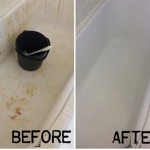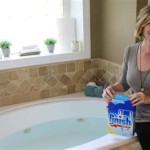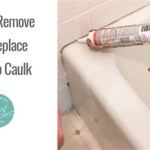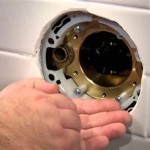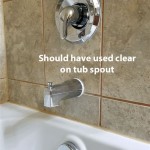Home Remedies to Clean Enamel Bathtubs
Enamel bathtubs, prized for their durability and classic aesthetic, require regular cleaning to maintain their luster and prevent the build-up of soap scum, hard water stains, and mildew. While commercially available cleaning products are readily accessible, many homeowners prefer using home remedies for their effectiveness, affordability, and eco-friendliness. These solutions often utilize readily available household ingredients, minimizing exposure to harsh chemicals and promoting a safer cleaning environment.
The key to successfully cleaning an enamel bathtub with home remedies lies in understanding the composition of common bathroom grime and choosing the appropriate cleaning agent. Soap scum, a common culprit, is formed by the reaction of soap with hard water minerals. Hard water stains are mineral deposits that can create unsightly rings and discolorations. Mildew, a type of fungus, thrives in moist environments and can present health concerns if left unchecked.
Different types of enamel exist, though most modern bathtubs feature porcelain enamel fused to a cast iron or steel base. While durable, enamel surfaces can be scratched or etched by abrasive cleaners, so gentleness is always recommended when selecting and applying cleaning solutions. The following sections explore several effective home remedies for cleaning enamel bathtubs safely and efficiently.
Baking Soda and Vinegar: A Powerful Cleaning Duo
The combination of baking soda and vinegar is a versatile and effective cleaning solution for various household surfaces, including enamel bathtubs. Baking soda, a mild alkali, acts as a gentle abrasive, helping to loosen dirt and grime. Vinegar, a mild acid, helps dissolve mineral deposits and soap scum. The chemical reaction between the two creates carbon dioxide, providing a natural scrubbing action.
To clean an enamel bathtub with baking soda and vinegar, begin by rinsing the bathtub thoroughly with water. This removes loose debris and prepares the surface for cleaning. Next, sprinkle a generous amount of baking soda over the entire surface of the bathtub, paying particular attention to areas with visible stains or grime. You can also make a paste of baking soda and water for targeted stain removal.
After applying the baking soda, pour white vinegar over the baking soda-covered surface. You will observe a foaming reaction as the vinegar interacts with the baking soda. Allow this mixture to sit for approximately 15-30 minutes. The duration depends on the severity of the stains and grime. For heavily soiled areas, you may need to allow the mixture to sit for a longer period.
Once the mixture has sat for the allotted time, use a non-abrasive sponge or cloth to scrub the bathtub surface. The baking soda acts as a gentle abrasive, while the vinegar helps to dissolve any remaining residue. Avoid using harsh scrubbing pads or steel wool, as these can scratch the enamel surface. Pay particular attention to areas around the drain and faucet, where soap scum and mineral deposits tend to accumulate.
After scrubbing, rinse the bathtub thoroughly with water to remove all traces of baking soda and vinegar. Use a clean cloth to dry the bathtub, preventing water spots and further mineral build-up. For stubborn stains, you may need to repeat the process or use a more concentrated baking soda paste.
This method is also effective at cleaning drains. Pouring the baking soda and vinegar mixture down the drain can help to break down clogs and eliminate odors. After allowing the mixture to sit for 30 minutes, flush the drain with hot water for several minutes.
Lemon Juice and Salt: A Natural Stain Remover
Lemon juice, with its natural acidity, makes an excellent cleaning agent for removing stains and brightening enamel surfaces. Salt acts as a mild abrasive, helping to scrub away dirt and grime without scratching the surface. The combination of lemon juice and salt provides a natural and effective cleaning solution, particularly for tackling hard water stains and soap scum.
To use lemon juice and salt to clean an enamel bathtub, start by cutting a lemon in half. Sprinkle a generous amount of salt onto the cut surface of the lemon. Use the salted lemon to scrub the bathtub surface, focusing on areas with stains or grime. The lemon juice will help to dissolve the stains, while the salt provides a gentle abrasive action.
For particularly stubborn stains, you can create a paste of lemon juice and salt. Mix a few tablespoons of lemon juice with enough salt to form a thick paste. Apply the paste to the stained area and allow it to sit for approximately 15-30 minutes. Then, scrub the area with a non-abrasive sponge or cloth and rinse thoroughly with water.
Lemon juice is also effective at removing rust stains from enamel surfaces. Apply lemon juice directly to the rust stain and allow it to sit for several hours, or even overnight. Then, scrub the area with a non-abrasive sponge or cloth and rinse thoroughly with water. You may need to repeat the process several times to completely remove the rust stain.
Furthermore, lemon juice can be used to naturally disinfect the bathtub. Its acidic properties kill bacteria and fungi, leaving the bathtub fresh and clean. After cleaning the bathtub with your preferred method, spray the surface with lemon juice and let it sit for 10-15 minutes before rinsing it off.
After cleaning, ensure that all traces of lemon juice and salt are removed from the surface, as prolonged exposure to the acidic juice could potentially etch the enamel. Regular use of this method can help prevent the build-up of stains and keep your enamel bathtub looking its best.
Cream of Tartar Paste: Polishing and Stain Removal
Cream of tartar, a byproduct of winemaking, possesses mild abrasive and acidic properties that make it a useful cleaning agent for enamel bathtubs. It's particularly effective for removing stains and polishing the surface to restore its shine. Cream of tartar is also a gentle alternative to harsher scrubbing powders, minimizing the risk of scratching the enamel.
To create a cream of tartar cleaning paste, mix the powder with water until a thick, spreadable consistency is achieved. The precise ratio will vary depending on the desired thickness, but a good starting point is approximately two parts cream of tartar to one part water. Adjust the mixture as needed to achieve the desired consistency.
Before applying the paste, dampen the enamel bathtub surface with water. This helps the paste adhere and prevents it from drying out too quickly. Apply the cream of tartar paste to the entire surface of the bathtub, paying particular attention to areas with stains, soap scum, or water spots. Allow the paste to sit for approximately 15-20 minutes to allow the cream of tartar to penetrate the grime.
After the paste has sat for the allotted time, use a soft, non-abrasive sponge or cloth to gently scrub the bathtub surface. Avoid using excessive pressure or harsh scrubbing pads, as these can scratch the enamel. Focus on circular motions to effectively lift dirt and grime. For stubborn stains, you may need to apply more paste and scrub for a longer duration.
Once you have thoroughly scrubbed the bathtub, rinse the surface completely with water to remove all traces of the cream of tartar paste. Inspect the bathtub for any remaining stains or residue. If necessary, repeat the process for particularly stubborn areas. Finally, dry the bathtub with a clean, soft cloth to prevent water spots and restore its shine.
The cream of tartar paste can also be used to clean metal fixtures in the bathroom, such as faucets and showerheads. Apply the paste to the metal surface, allow it to sit for a few minutes, and then scrub with a soft cloth. Rinse thoroughly with water and dry with a clean cloth to restore the shine.
Regular use of cream of tartar paste can help prevent the build-up of stains and keep your enamel bathtub looking clean and polished. Its gentle abrasive properties make it a safe and effective cleaning solution for maintaining the beauty of your enamel surfaces.

How To Clean Your Bathtub The Home Depot

Tips On How To Remove Bathtub Stains Naturally

How To Clean A Bath Complete Guide Elegant Showers

Cleaning The Bathtub Best Tips Home Remedies

Cleaning The Bathtub Best Tips Home Remedies

Baking Soda Bleach And Vinegar Which Is Best For A Clean Bathtub 2025

4 Household S That Remove Stains From Your Bath

3 Ways To Clean An Enamel Bathtub Wikihow

How To Clean Your Bathtub The Right Way Easier Than You Think

How To Clean A Bath Complete Guide Elegant Showers
Related Posts

